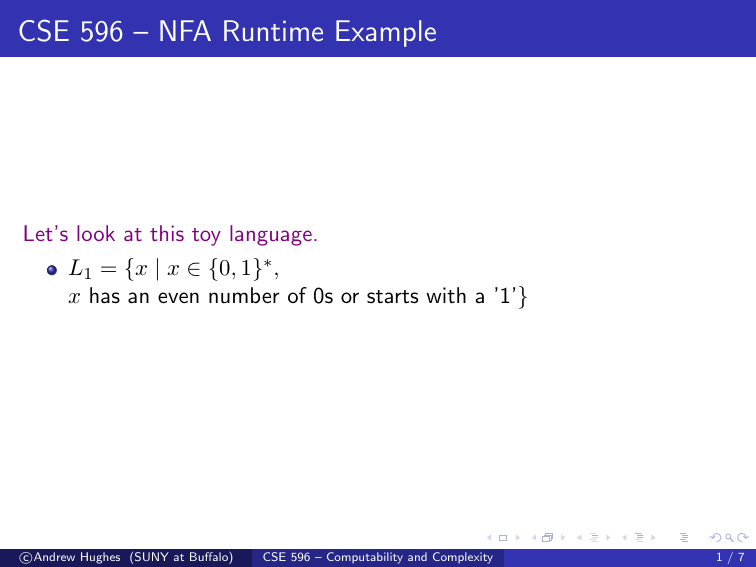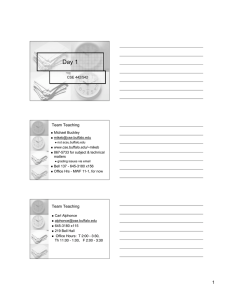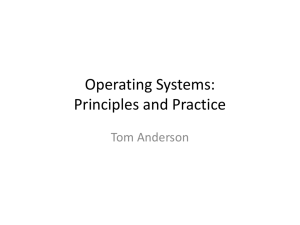Document 10534984
advertisement

CSE 596 – NFA Runtime Example
Let’s look at this toy language.
L1 = {x | x ∈ {0, 1}∗ ,
x has an even number of 0s or starts with a ’1’}
c Andrew Hughes (SUNY at Buffalo)
CSE 596 – Computability and Complexity
1/7
CSE 596 – NFA Runtime Example
Here is an NFA that accepts our language L1 :
1
1
0
qodd 0s
qeven 0s
0
λ
start
q0
1
qstart 1
c Andrew Hughes (SUNY at Buffalo)
0,1
CSE 596 – Computability and Complexity
2/7
CSE 596 – NFA Runtime Example
What does the computation of w = 1000 on our NFA look like?
c Andrew Hughes (SUNY at Buffalo)
CSE 596 – Computability and Complexity
3/7
CSE 596 – NFA Runtime Example
Current states = {q0 }, w = 1000
1
start
q0
λ
1
0
qeven 0s
qodd 0s
0
1
qstart 1
c Andrew Hughes (SUNY at Buffalo)
0,1
CSE 596 – Computability and Complexity
4/7
CSE 596 – NFA Runtime Example
Current states = {q0 }, w = 1000
1
start
q0
λ
1
0
qeven 0s
qodd 0s
0
1
qstart 1
0,1
Before we look at any symbols we can make a λ-move.
c Andrew Hughes (SUNY at Buffalo)
CSE 596 – Computability and Complexity
4/7
CSE 596 – NFA Runtime Example
Current states = {q0 , qeven 0s }, w = 1000
1
start
q0
λ
1
0
qeven 0s
qodd 0s
0
1
qstart 1
c Andrew Hughes (SUNY at Buffalo)
0,1
CSE 596 – Computability and Complexity
5/7
CSE 596 – NFA Runtime Example
Current states = {q0 , qeven 0s }, w = 1000
1
start
q0
λ
1
0
qeven 0s
qodd 0s
0
1
qstart 1
0,1
Now we will look at input symbols. The idea is that before we make a
transition using symbols, we make any possible transitions using λ-moves
first.
c Andrew Hughes (SUNY at Buffalo)
CSE 596 – Computability and Complexity
5/7
CSE 596 – NFA Runtime Example
Current states = {q0 , qeven 0s }, w = 1000
1
start
q0
λ
1
0
qeven 0s
qodd 0s
0
1
qstart 1
c Andrew Hughes (SUNY at Buffalo)
0,1
CSE 596 – Computability and Complexity
6/7
CSE 596 – NFA Runtime Example
Current states = {q0 , qeven 0s }, w = 1000
1
start
q0
λ
1
0
qeven 0s
qodd 0s
0
1
qstart 1
0,1
Given the set of states and reading symbol ’1’, we need to look at all
possible transitions based on our current states.
c Andrew Hughes (SUNY at Buffalo)
CSE 596 – Computability and Complexity
6/7
CSE 596 – NFA Runtime Example
Current states = {q0 , qeven 0s }, w = 1000
1
start
q0
λ
1
0
qeven 0s
qodd 0s
0
1
qstart 1
0,1
Given the set of states and reading symbol ’1’, we need to look at all
possible transitions based on our current states.
This gives: δ(q0 , 1) = {qstart 1 } and δ(qeven 0s , 1) = {qeven 0s }.
c Andrew Hughes (SUNY at Buffalo)
CSE 596 – Computability and Complexity
6/7
CSE 596 – NFA Runtime Example
Current states = {q0 , qeven 0s }, w = 1000
1
start
q0
λ
1
0
qeven 0s
qodd 0s
0
1
qstart 1
0,1
Given the set of states and reading symbol ’1’, we need to look at all
possible transitions based on our current states.
This gives: δ(q0 , 1) = {qstart 1 } and δ(qeven 0s , 1) = {qeven 0s }.
We combine the results (take the union) to give us our new set of states:
{qstart 1 , qeven 0s }.
c Andrew Hughes (SUNY at Buffalo)
CSE 596 – Computability and Complexity
6/7
CSE 596 – NFA Runtime Example
Current states = {qstart 1 , qeven 0s }, w = 1000
1
start
q0
λ
1
0
qeven 0s
qodd 0s
0
1
qstart 1
c Andrew Hughes (SUNY at Buffalo)
0,1
CSE 596 – Computability and Complexity
7/7
CSE 596 – NFA Runtime Example
Current states = {qstart 1 , qeven 0s }, w = 1000
1
start
q0
λ
1
0
qeven 0s
qodd 0s
0
1
qstart 1
0,1
Before we make the transition for the next symbol, we have to ask if there
are any λ-moves out of any of our current states, which there are not. If
there were λ-moves we would keep adding states to the set via those
moves until there were no more states to be added.
c Andrew Hughes (SUNY at Buffalo)
CSE 596 – Computability and Complexity
7/7
CSE 596 – NFA Runtime Example
Current states = {qstart 1 , qeven 0s }, w = 1000
1
start
q0
λ
1
0
qeven 0s
qodd 0s
0
1
qstart 1
c Andrew Hughes (SUNY at Buffalo)
0,1
CSE 596 – Computability and Complexity
8/7
CSE 596 – NFA Runtime Example
Current states = {qstart 1 , qeven 0s }, w = 1000
1
start
q0
λ
1
0
qeven 0s
qodd 0s
0
1
qstart 1
0,1
Given this information, our new set of states becomes {qstart 1 , qodd 0s }.
Again, there are no λ-moves from these states so this is our new set of
states.
c Andrew Hughes (SUNY at Buffalo)
CSE 596 – Computability and Complexity
8/7
CSE 596 – NFA Runtime Example
Current states = {qstart 1 , qodd 0s }, w = 1000
1
start
q0
λ
1
0
qeven 0s
qodd 0s
0
1
qstart 1
c Andrew Hughes (SUNY at Buffalo)
0,1
CSE 596 – Computability and Complexity
9/7
CSE 596 – NFA Runtime Example
Current states = {qstart 1 , qodd 0s }, w = 1000
1
start
q0
λ
1
0
qeven 0s
qodd 0s
0
1
qstart 1
0,1
Given this information, our new set of states becomes {qstart 1 , qeven 0s }
c Andrew Hughes (SUNY at Buffalo)
CSE 596 – Computability and Complexity
9/7
CSE 596 – NFA Runtime Example
Current states = {qstart 1 , qeven 0s }, w = 1000
1
start
q0
λ
1
0
qeven 0s
qodd 0s
0
1
qstart 1
c Andrew Hughes (SUNY at Buffalo)
0,1
CSE 596 – Computability and Complexity
10 / 7
CSE 596 – NFA Runtime Example
Current states = {qstart 1 , qeven 0s }, w = 1000
1
start
q0
λ
1
0
qeven 0s
qodd 0s
0
1
qstart 1
0,1
Given this information, our new set of states becomes {qstart 1 , qodd 0s }
c Andrew Hughes (SUNY at Buffalo)
CSE 596 – Computability and Complexity
10 / 7
CSE 596 – NFA Runtime Example
Current states = {qstart 1 , qodd 0s }, w = 1000
1
start
q0
λ
1
0
qeven 0s
qodd 0s
0
1
qstart 1
c Andrew Hughes (SUNY at Buffalo)
0,1
CSE 596 – Computability and Complexity
11 / 7
CSE 596 – NFA Runtime Example
Current states = {qstart 1 , qodd 0s }, w = 1000
1
start
q0
λ
1
0
qeven 0s
qodd 0s
0
1
qstart 1
0,1
We have finished reading all the characters and all transitions are finished.
c Andrew Hughes (SUNY at Buffalo)
CSE 596 – Computability and Complexity
11 / 7
CSE 596 – NFA Runtime Example
Current states = {qstart 1 , qodd 0s }, w = 1000
1
start
q0
λ
1
0
qeven 0s
qodd 0s
0
1
qstart 1
0,1
We have finished reading all the characters and all transitions are finished.
Now we need to decide if this string was accepted by the NFA.
c Andrew Hughes (SUNY at Buffalo)
CSE 596 – Computability and Complexity
11 / 7
CSE 596 – NFA Runtime Example
Current states = {qstart 1 , qodd 0s }, w = 1000
1
start
q0
λ
1
0
qeven 0s
qodd 0s
0
1
qstart 1
0,1
We have finished reading all the characters and all transitions are finished.
Now we need to decide if this string was accepted by the NFA.
Well if any of our current states belong to F, i.e., are accepting, then we
say the string is accepted. Since qstart 1 ∈ F w is accepted by this NFA.
c Andrew Hughes (SUNY at Buffalo)
CSE 596 – Computability and Complexity
11 / 7







